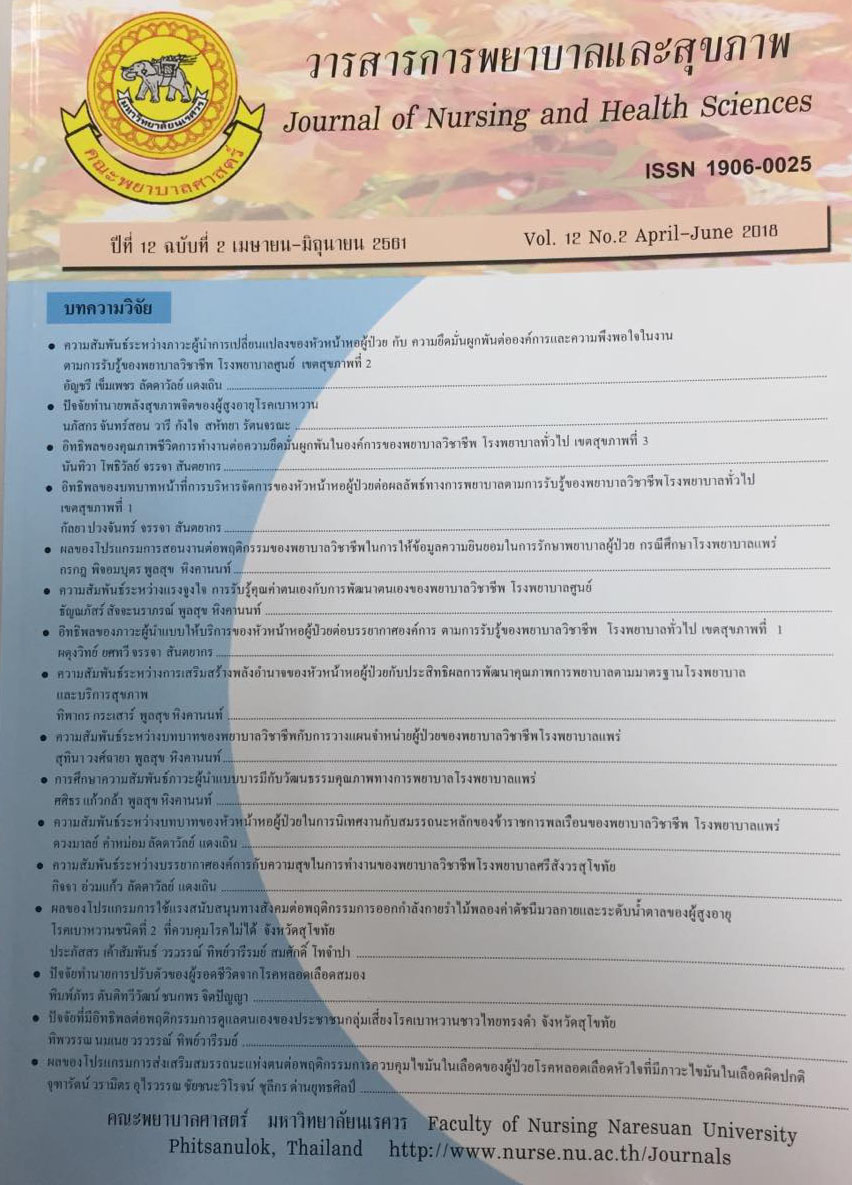Predictive Factors of Resilience among Elderly with Diabetes
Main Article Content
Abstract
The purpose of this predictive correlational study were to determine the resilience in odder adults with diabetes andthe predictive factors of resilience among older adults with diabetes. The participants were 108 male and female older adults aged 60 and older who had been diagnosed type 2 diabetes and received care at OPD, Banna Hospital, NakhonNayokprovince between July to August, 2016. They were selected by using simple random sampling technique. Demographic Questionnaire, Perceived Health Status Scale, Coping Scale, Instrumental Activity of Daily Living (Chula ADL Index) Questionnaire, Social Support Questionnaire, and the Resilience Scale were used to collect data. Cronbarch's alpha coefficients of these instruments were .74, .79, .85, .87 and.83 respectively. Descriptive statistics and stepwise multiple regression were used to analyze the data. The results indicated that the mean resilience score of the participants was at a high level ( = 147 .16, SD = 12.32). Social support, perceived health status, and IADLs all together could predict 43.6% of the variance in resilience (R2 = .436, p < .01). These findings suggest that nurses and healthcare staffs should providenursing interventionto enhance social support, perception of health status, and functional activity in order to improve resilience in older adults with diabetes.
Article Details
References
ความสามารถในการดูแลตนเองของผู้สูงอายุ
โรคมะเร็งที่ได้รับยาเคมีบำบัด. วิทยานิพนธ์
พยาบาลศาสตรมหาบัณฑิต, สาขาวิชาการ
พยาบาลผู้สูงอายุ, บัณฑิตวิทยาลัย, จุฬาลงกรณ์
มหาวิทยาลัย.
กรมการแพทย์ กระทรวงสาธารณสุข. (2557). แนวทาง
เวชปฏิบัติสำหรับโรคเบาหวาน 2557. กรุงเทพฯ:
ศรีเมืองการพิมพ์.
งานเทคโนโลยีสารสนเทศโรงพยาบาลบ้านนา.
(2558). งานเทคโนโลยีสารสนเทศ กลุ่มภารกิจ
ด้านอำนวยการ. นครนายก: โรงพยาบาลบ้านนา.
ฉัตรฤดี ภาระญาติและวารี กังใจ. (2559). ปัจจัย
ทำนายพลังสุขภาพจิตของผู้สูงอายุ. วารสาร
คณะพยาบาลศาสตร์มหาวิทยาลัยบูรพา, 24(2),
97-106.
ชื่นฤทัย กาญจนะจิตรา, ชาย โพธิสิตา, กฤตยา อาชวนิจกุล,
อุมาภรณ์ ภัทรวาณิชย์, กุลวีณ์ศิริรัตน์มงคล,
หทัยรัตน์ เสียงดัง และสุภรต์ จรัสสิทธิ์. (2550).
สุขภาพคนไทย 2550 "หอมกลิ่นลำดวน" เตรียม
พร้อมสู่สังคมผู้สูงอายุ. กรุงเทพฯ: อมรินทร์
พริ้นติ้งแอนด์พับลิชชิ่ง.
ดวงเดือน รัตนะมงคลกุล, สมสมัย สังขมณี, สุธีร์
รัตนะมงคลกุล, วิมลวรรณ เลิศวงศ์เผ่าพันธ์ุ และ
สิร์ดาภัทร สุขฉวี.(2015). ภาพสุขภาวะของผู้สูงอายุ
ผ่านมุมมองพฤฒพลังในชุมชนจังหวัดนครนายก.
Journal of Medicine and Health Sciences,
22(2), 48-60.
ประเสริฐ อัสสันตชัย. (2556). ปัญหาสุขภาพที่พบบ่อย
ในผู้สูงอายุและการป้องกัน. กรุงเทพฯ: ยูเนี่ยน
ครีเอชั่น.
ปราณี มิ่งขวัญ. (2542). ความเครียดและการเผชิญ
ความเครียดในผู้ป่วยสูงอายุโรคหลอดเลือดสมอง.
วิทยานิพนธ์พยาบาลศาสตร มหาบัณฑิต,
สาขาวิชาการพยาบาลผู้สูงอายุ, บัณฑิตวิทยาลัย,
มหาวิทยาลัยเชียงใหม่.
Ç¹Ô´Ò ËҤسҡØÅ. (2539). ¼Å¢Í§¡ÒÃÊè§àÊÃÔÁ¡ÒÃ
»ÃѺµÑÇÍÂèÒ§ÁÕẺἹµèÍ¡ÒÃÃѺÃÙéÀÒÇÐÊØ¢ÀÒ¾
áÅСÒûÃѺµÑÇã¹¼Ùé»èÇÂâä¡ÅéÒÁà¹×éÍËÑÇ㨵ÒÂ.
ÇÔ·ÂÒ¹Ô¾¹¸ì¾ÂÒºÒÅÈÒʵÃÁËҺѳ±Ôµ,
ÊÒ¢ÒÇÔªÒ¡ÒþÂÒºÒżÙéãËè, ºÑ³±ÔµÇÔ·ÂÒÅÑÂ,
ÁËÒÇÔ·ÂÒÅÑÂÁËÔ´Å.
ÇÔäÅÇÃó ·Í§à¨ÃÔ. (2554). ÈÒʵÃìáÅÐÈÔÅ»ì¡ÒÃ
¾ÂÒºÒżÙéÊÙ§ÍÒÂØ. ¡Ãا෾Ï: â¤Ã§¡ÒõÓÃÒ
¤³Ð¾ÂÒºÒÅÈÒʵÃì ÁËÒÇÔ·ÂÒÅÑÂÁËÔ´Å.
ʶҺѹàǪÈÒʵÃì¼ÙéÊÙ§ÍÒÂØ. (2542). Ẻ·´Êͺ
ÊÀÒ¾ÊÁͧàº×éͧµé¹ ©ºÑºÀÒÉÒä·Â MMSEThai
2002. ¹¹·ºØÃÕ: ʶҺѹàǪÈÒʵÃì¼ÙéÊÙ§ÍÒÂØ
¡ÃÁ¡ÒÃá¾·Âì ¡ÃзÃǧÊÒ¸ÒóÊØ¢.
ÊØ·¸ÔªÑ ¨ÔµÐ¾Ñ¹¸ì¡ØÅ. (2542). ËÅÑ¡ÊӤѢͧàǪÈÒʵÃì
¼ÙéÊÙ§ÍÒÂØ (¾ÔÁ¾ì¤ÃÑ駷Õè 2).¡Ãا෾Ï: ¤³Ðá¾·Âì
ÈÒʵÃì¨ØÌÒŧ¡Ã³ìÁËÒÇÔ·ÂÒÅÑÂ.
ÍÁÃÒ ·Í§Ë§Éì, ¡ÁŪ¹¡ à·¾ÊÔ·¸Ò áÅÐÀÒ¤ÀÙÁÔ
¨§¾ÔÃÔÂÐ͹ѹµì. (2555).ÃÒ§ҹ¡ÒÃà½éÒÃÐÇѧâä
äÁèµÔ´µèÍàÃ×éÍÃѧ ¾.È. 2555. ¹¹·ºØÃÕ: ÊӹѡÃкҴ
ÇÔ·ÂÒ ¡ÃÁ¤Çº¤ØÁâä¡ÃзÃǧÊÒ¸ÒóÊØ¢.
Bahremand, M., Rai, A., Alikhani, M., Mohammadi,
S., Shahebrahimi, K., &Janjani, P. (2015).
Relationship between family functioning and
mental health considering the mediating role of
resiliency in type 2 diabetesmellitus patients.
Global Journal of Health Science, 7(3), 254-
259.
Brook, R. H., Ware, J. E., Davies-Avery, A., Stewart,
A. L., Donald, C. A., Rogers, W. H., Williams,
K. N., & Johnston, S. A. (1979). Overview of
adult health status measures fielded in Rand's
health insurance study. Medical Care, 17(S7),
1-131.
Celano, C. M., Beale, E. E., Moore, S. V., Wexler, D.
J., & Huffman, J. C. (2013). Positive psychological
characteristics in diabetes: A review.
Current Diabetes Report, 13, 917-929.
Centers for Disease Control and Prevention. (2014).
National diabetes statistics report: Estimates of
diabetes and its burden in the United States,
2014. Atlanta: U.S. Department of Health and
Human Services.
Choowattanapakorn, T., Alex, L., Lundman, B.,
Norberg, A., &Nygren, B. (2010). Resilience
among older women and men aged 60 years
and over in Sweden and in Thailand.
Nursingand Health Sciences, 12, 329-335.
Grotberg, E. H. (2003). Resilience for today: Gaining
strength from adversity. Westport: Praeger.
Hardy, S. E., Concato, J., & Gill, T. M. (2004).
Resilience of community-dwelling older
persons. Journal of the American Geriatrics
Society, 52(2), 257-262.
Hengudomsub, P. (2007). Resilience in later life.
Thai Pharmaceutical and Health Science
Journal. 2(1), 115-123.
House, J. S. (1981). Work stress and social support.
New Jersey: Prentice Hall.
Jalowiec, A. (1988). Confirmatory factor analysis of the
Jalowiec coping scale. In C. F.Waltz, &O. L.
Strickland (Eds), Measurements of nursing
outcomes: Measuring client outcomes (pp. 287-
308). New York: Springer.
Jitapunkul, S., Kamolratanakul, P., Chandraprasert, S.,
&Bunnag, S. (1994).Disability among Thai
elderly living in KlongToey slum.Journal of
the Medical Association of Thailand, 77(5),
231-238.
Kirkman, M. S., Briscoe, V. J., Clark, N., Florez, H.,
Haas, L. B., Halter, J. B., Huang, E. S.,
Korytkowski, M. T., Munshi, M. N., Odegard,
P. S., Pratley, R. E., & Swift, C. S. (2012).
Diabetes in older adults: A consensus report.
Journal of the American Geriatrics Society, 60,
2342-2356.
Lazarus, R. S., &Folkman, S. (1984). Stress, appraisal,
and coping. New York: Springer.
Li, Y., Burrows, N. R., Gregg, E. W., Albright, A.,
&Geiss, L. S. (2012). Declining rates of
hospitalization for nontraumatic lowerextremity
amputation in the diabetic population
aged 40 years or older: U.S., 1988-2008.
Diabetes Care, 35, 273-277.
Resnick, B., Gwyther, L. P., & Roberto, K. A. (Eds.).
(2011). Resilience in aging: Concepts, research,
andoutcomes. New York: Springer.
Stewart, D. E., & Yuen,T. (2011).A systematic review
of resilience in the physically ill.Psychosomatic,
52(3), 199-209.
Tabachnick, B. G., &Fidell, L. (2013).Using multivariate
statistics (6th ed.). New Jersey: Pearson.
Touhy, T. A., & Jett, K. F. (2012).Ebersole & Hess'
toward healthy aging : Human needs &
nursingresponse (8th ed.). St. Louis: Elsevier Mosby.
Wagnild, G. (2003). Resilience and successful aging:
Comparison among low and high income older
adults. Journal of Gerontological Nursing,
29(12), 42-49.
Wagnild, G.M., &Young, H. M. (1993). Development
and psychometric evaluation of the resilience
scale. Journal of Nursing Measurement, 1(2),
165-178.
Wagnild, G., & Collins, J. A. (2009).Assessing resilience.
Psychosocial Nursing, 47(12), 28-33.
Well, M. (2010). Resilience in older adults living in
rural, suburban, and urban areas.Journal of Rural
Nursing and Health Care, 10(2), 45-54.
Yi-Frazier, J. P., Smith, R. E., Vitaliano, P. P., Yi, J. C.,
Mai, S., Hillman, M., &Weinger, K. (2009). A
person-focused analysis of resilienceresources
and coping in patients with diabetes.Stress and
Health, 26, 51-60.


